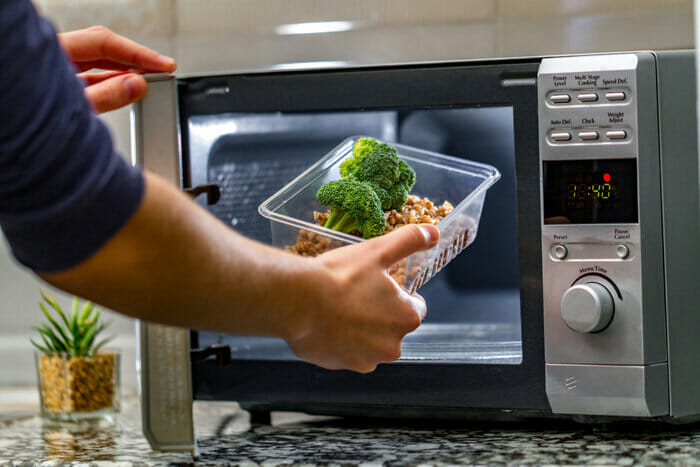Last Updated on January 1, 2023 by Mosabbir
All of us want a convenient kitchen life, and there is nothing easier than reheating the meal in a microwave within seconds or minutes.
But, it would be best if you have microwave-safe plastic containers to reheat the eatables at home.
Many of us might not know that using incorrect containers inside a microwave can lead to severe problems.
For instance, microwaves can melt certain plastics, which release harmful additives like BPA into your meals or beverages.
Well, there is more. A wrong plastic might result in fire or damage your microwave. So, it’s critical to use safe plastic inside a microwave.
In this post, we will discuss the plastic types that are safe inside the microwave. We will also let you know the plastic numbers that you should never put inside a microwave.
What Containers Are Not Microwave Safe?
Plastic 3, 6 and 7
The number cannot state whether it’s recyclable or not. But the digit confirms whether you are using microwave-safe plastic or not. Do not place type 3 (PVC), 6 (polystyrene), and 7 (polycarbonate) inside your microwave.
These variants can release toxins in your food items. For example, bisphenol A is a harmful element that might mix in your meat or beverage if you use one of these plastic types.
Polystyrene, also known as Styrofoam, is inexpensive and also keeps your food items warm during transport. But, it can release unwanted elements in your eatables. It’s the reason Styrofoam is banned in multiple regions.
Also read: How To Clean a Microwave After a Fire?
Sometimes safe – Plastic 1, 2, 4
We do not recommend using plastic types 1 (polyethylene terephthalate), 2 (high-density polyethylene), and 4 (low-density polyethylene), but you can proceed with caution. These variants are safe if they are built with chemicals that can prevent melting when inside a microwave.
Especially plastic #2 High-Density Polyethylene (HDPE) is microwave-safe because it can tolerate temperatures between -40 to 130 degrees Celsius.
HDPE is usually used to manufacture food containers. As a result, it’s long-lasting and doesn’t deteriorate quickly. Plus, you can reuse it without any hygiene issues.
What Containers Are Microwaves Safe?
Plastic #5 Polypropylene (PP)
Polypropylene is safe plastic for your microwave because it can tolerate temperatures between -17 to 121 degrees Celsius.
It’s why pp 5 plastic microwave is used for food containers, bowls, and catering plates. Plus, polypropylene is lightweight, durable, and safe to reuse. However, it might not be acceptable in all the recycling units.
All the plastic types are generally manufactured using petroleum, which means they release chemicals when exposed to high temperatures.
So, we suggest discontinuing using a plastic container, bowl, or plate when it wears out.
Things to remember
Keep in mind that most plastic manufacturers don’t research whether their end product is safe for food items or microwaves.
For example, bisphenol A (BPA) is a cancer-causing agent, which causes health problems for human beings, especially kids who use a bottle to drink milk.
It can release inside the food or beverage under high temperatures and contribute to breast cancer and low sperm count.
Also read: How Many Watts Does a Microwave Oven Use?
FAQs
Why is microwaving plastic bad?
Heating or microwaving plastic is dangerous because it might release toxic chemicals into your eatables. Consuming such elements can result in metabolic troubles like obesity, breast cancer, and even reduced fertility. The chances are higher if the plastic is exposed to high temperatures.
Is it safe to microwave BPA-free plastic?
You can microwave BPA-free plastic, but make sure you shift the food items to a different container. It’s best to use glass, ceramic, and steel to transfer your eatables. Plus, always try to use type 5 plastic inside a microwave.
How can you tell if a plastic container is microwave safe?
If a plastic container clearly states “microwave safe”, it’s safe to use inside the appliance. You can check it on the printed description. If you cannot find this microwave-safe symbol, look for one of the numbers discussed above. As we discussed, 24, and 5 are the only food-grade plastic numbers.
Also read: Best Basic Microwave Oven UK of 2023
The Final Words
Choosing suitable plastic containers for the microwave is essential. Keep in mind that the product usage differs according to the make and model.
Do not use a plastic plate or container inside a microwave if you are not sure whether it can deal with the radiation or not. Check for a microwavable sign to be sure.
Apart from plastic, glass and ceramic works well in the oven and keep your food items safe from harmful chemicals.
So, next time try a Pyrex or CorningWare when you want to reheat or cook something using a microwave.
